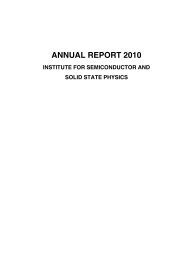Kinetic and Strain-Induced Self-Organization of SiGe ...
Kinetic and Strain-Induced Self-Organization of SiGe ...
Kinetic and Strain-Induced Self-Organization of SiGe ...
Create successful ePaper yourself
Turn your PDF publications into a flip-book with our unique Google optimized e-Paper software.
26 CHAPTER 2. MOLECULAR BEAM EPITAXY (MBE)<br />
2.3.2 Evaporation <strong>and</strong> Rate Measurement<br />
In this MBE-system electron beam evaporators for silicon, germanium <strong>and</strong> carbon are used<br />
for the deposition <strong>of</strong> the main epilayer constituents. In the course <strong>of</strong> this thesis the two<br />
formerly small e-beam evaporators for Ge <strong>and</strong> C were replaced by a larger Ge-source (see<br />
Ch. 8). Effusion cells for boron (B, p-type doping) <strong>and</strong> antimony (Sb, n-type doping) are<br />
used <strong>and</strong> also a carbon sublimation cell is installed. The chamber for special processes is<br />
equipped with a C60-effusion cell <strong>and</strong> can be upgraded <strong>and</strong> supplied with additional sources,<br />
such as for manganese (Mn), in the future.<br />
The evaporation rates <strong>of</strong> the resistively heated effusion cells are temperature controlled. The<br />
temperature is measured with tungsten-rhenium thermocouples (Rh 5%/26%) mounted di-<br />
rectly below the radiativly heated crucible, <strong>and</strong> can be stabilized using feed-back loops to<br />
adjust the heating currents.<br />
Since in this work mainly epilayers consisting <strong>of</strong> silicon <strong>and</strong> germanium were grown, in the<br />
following the description is restricted to these sources. The schematic principle <strong>of</strong> an elec-<br />
tron beam evaporator is sketched in Fig. 2.8 [12]. A resistively heated hot filament emits<br />
thermionic electrons that are accelerated to an energy <strong>of</strong> 10 keV. This electron beam is de-<br />
flected by a static magnetic field following a 270 ◦ arc. The beam strikes the target material<br />
which is heated up <strong>and</strong> evaporated locally. With moderately high power (∼ 1 kW) growth<br />
rates <strong>of</strong> typically ∼ 0.4 ˚A/s for Si <strong>and</strong> ∼ 0.025 ˚A/s for Ge can be realized. In the case <strong>of</strong> Si<br />
<strong>and</strong> Ge the evaporation material is located in a crucible <strong>of</strong> pure silicon that is mounted in<br />
a water-cooled copper hearth. A water-cooled ro<strong>of</strong> (stainless steel) that is screened towards<br />
the evaporator by Si shields confines the molecular beam.<br />
The growth rates are measured using a Sentinel III controller (Leybold Inficon). The mea-<br />
suring principle is based on electron impact emission spectroscopy (EIES). This is an optical<br />
technique, where the emission intensities <strong>of</strong> element-specific atomic transitions that are exited<br />
via electron impact, are measured. The signal intensity depends on the density <strong>of</strong> atoms <strong>and</strong><br />
therefore on the flux <strong>of</strong> the evaporated specimen. Growth rates ranging from 0.01 ˚A/s up<br />
to 2 ˚A/s can be conveniently measured, but have to be calibrated by the evaluation <strong>of</strong> thick<br />
Si homoepitaxial <strong>and</strong> <strong>SiGe</strong> heteroepitaxial epilayers using x-ray diffraction (see Ch. A) <strong>and</strong><br />
step-height measuring systems (Alpha-Stepper). [12, 53]<br />
2.3.3 Heating <strong>and</strong> Temperature Measurement<br />
Directly above the substrate holder a resistively heated graphite me<strong>and</strong>er serves as thermal ra-<br />
diation source. The substrate is heated by absorbing the radiation emitted from the graphite











